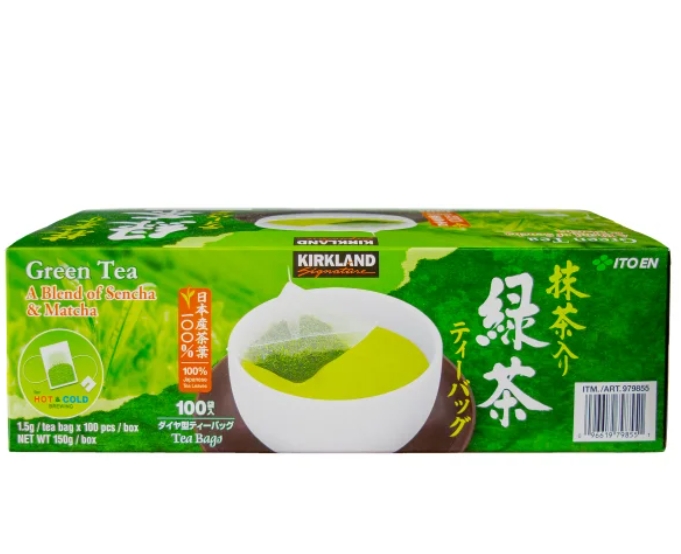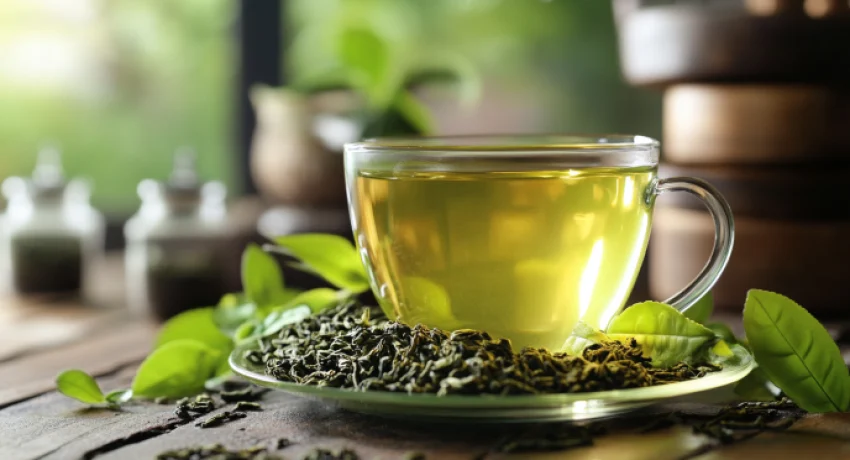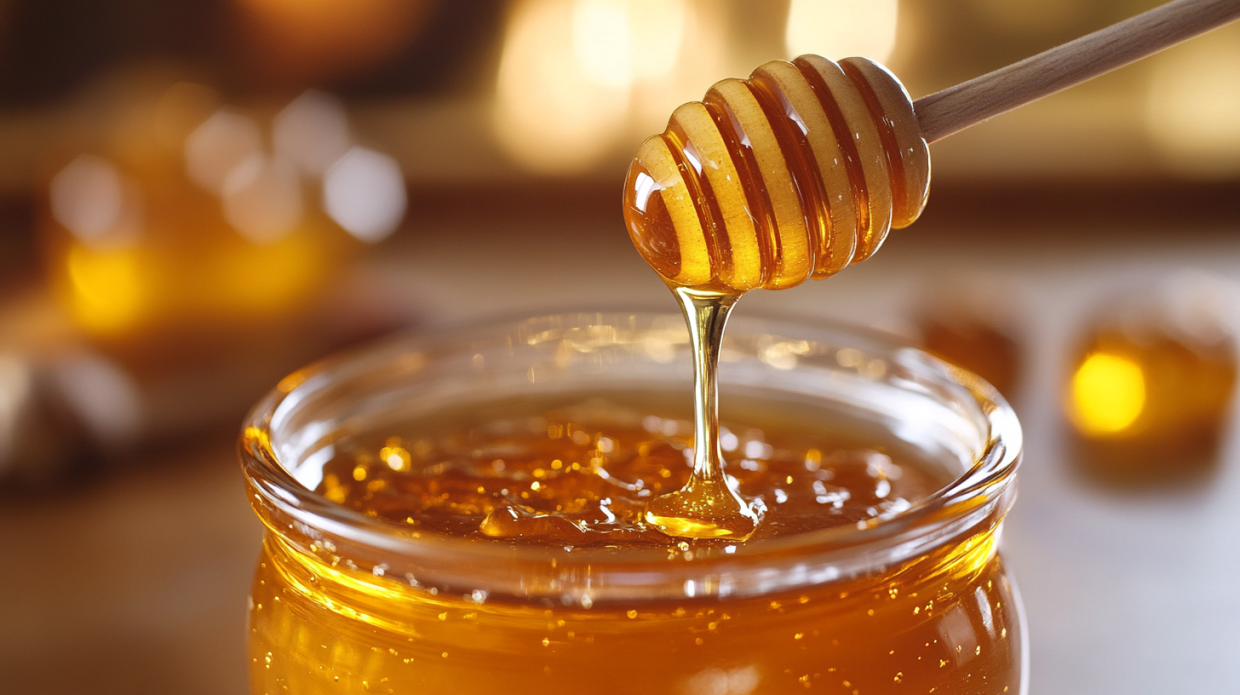
Kirkland Signature Green Tea Bags, 1.5 g, 100-count
- 100-count
- 1.5 g. bags
- A Blend of Sencha & Matcha
- Hot & Cold Brewing
- Product of Japan
How Costco’s Signature Green Tea Is Changing the Way We Drink
Green tea has been revered for centuries across Eastern cultures, but only in recent decades has the Western world begun to truly appreciate its nuanced flavors and remarkable health benefits. Among the sea of options available to consumers today, one particular brand has been quietly gaining a devoted following: Kirkland Signature Green Tea. As Costco’s house brand, Kirkland has managed to strike that elusive balance between quality and affordability that has tea enthusiasts and casual drinkers alike reaching for those distinctive green boxes.
I’ve spent the last month incorporating Kirkland Green Tea into my daily routine, and what started as simple curiosity has evolved into a genuine appreciation for this humble yet impressive product. Let’s dive into everything you need to know about this popular green tea option that might just change your tea-drinking experience forever.
The Essence of Kirkland Green Tea: Ingredients and Sourcing
When it comes to tea, simplicity often reigns supreme. Kirkland Signature Green Tea contains only one ingredient: pure green tea leaves. This no-nonsense approach to ingredients is refreshing in a market often cluttered with additives and artificial flavors. The tea leaves are carefully selected and processed to maintain their natural qualities and health benefits.
Many tea drinkers wonder about the organic status of their favorite brews. While Kirkland Green Tea isn’t certified organic, Costco maintains strict quality control standards for all their Kirkland Signature products. The company works with suppliers who follow responsible growing practices, though without the official organic certification.
The sourcing of tea leaves plays a crucial role in determining flavor profiles and quality. Kirkland Green Tea is sourced primarily from China, the ancestral home of green tea cultivation. Chinese green teas are known for their subtlety and slightly sweeter profile compared to their Japanese counterparts. The specific regions within China where Kirkland sources its tea leaves contribute to the balanced flavor that has made this product so popular among Costco members.
The journey from tea leaf to teacup is a fascinating one. After harvesting, the leaves undergo minimal oxidation (unlike black tea, which is fully oxidized). This preservation of the leaves’ natural state is what gives green tea its characteristic color and delicate flavor profile. The leaves are then dried and processed before being packaged into the familiar individually wrapped tea bags that Kirkland customers have come to know.
Value Proposition: Cost Analysis and Packaging
One of the most compelling aspects of Kirkland Green Tea is its exceptional value. A box containing 100 individually wrapped tea bags typically retails for around $12.99 at Costco stores (though prices may vary slightly by location). This breaks down to approximately 13 cents per tea bag—a fraction of what many specialty tea brands charge.
This value becomes even more apparent when you consider that each tea bag can often be used for multiple steepings, especially if you prefer a lighter brew. Some dedicated tea drinkers report getting two or even three cups from a single Kirkland tea bag, further extending its value.
The individual packaging of each tea bag serves multiple purposes. Beyond convenience, it helps preserve freshness by protecting the tea leaves from moisture, air, and light—the three enemies of tea preservation. The foil wrapping also makes Kirkland Green Tea an excellent option for travel or to keep at work, as each tea bag remains fresh until you’re ready to use it.
Costco’s bulk purchasing model aligns perfectly with products like tea that have a relatively long shelf life. While green tea is best consumed within a year of production for optimal flavor, properly stored Kirkland Green Tea can remain good quality for up to two years. The individual wrapping helps extend this timeframe by providing an additional barrier against environmental factors.
The Health Elixir: Benefits and Nutritional Profile
Green tea has been celebrated for centuries not just for its taste but for its impressive health benefits, and Kirkland Green Tea delivers these advantages in abundance. At the heart of green tea’s health profile are its powerful antioxidants, particularly catechins like EGCG (epigallocatechin gallate). These compounds help combat oxidative stress and free radical damage in the body.
The nutritional profile of Kirkland Green Tea is quite impressive for a zero-calorie beverage. Beyond the potent antioxidants, it contains small amounts of minerals like fluoride, which supports dental health. A standard cup of Kirkland Green Tea contains:
- 0 calories
- 0g fat
- 0g carbohydrates
- 0g protein
- Rich in polyphenols and flavonoids
- Contains L-theanine, an amino acid that promotes relaxation
For those monitoring their caffeine intake, it’s worth noting that Kirkland Green Tea does contain caffeine, though significantly less than coffee. An average cup contains approximately 25-35mg of caffeine, compared to 95-200mg in a typical cup of coffee. This moderate caffeine content provides a gentle energy boost without the jitters or crash often associated with stronger caffeinated beverages.
The health benefits of regular green tea consumption are wide-ranging and well-documented in scientific literature. Studies suggest that green tea may:
- Support heart health by helping to maintain healthy cholesterol levels
- Assist with weight management by potentially boosting metabolism
- Promote healthy cognitive function
- Support dental health and fresh breath
- Help maintain healthy blood sugar levels
- Support immune system function
- Contribute to healthy skin aging
For those interested in weight management, green tea has earned a reputation as a supportive beverage. The combination of caffeine and catechins may temporarily increase the body’s calorie-burning efficiency. While Kirkland Green Tea is not a magic solution for weight loss, it can be a beneficial addition to a balanced diet and regular exercise regimen.
It’s important to note that while green tea offers numerous health benefits, individual results may vary. Consistency is key—the most significant benefits come from regular consumption over time rather than occasional use.
The Brewing Ritual: Maximizing Flavor and Benefits
The way you brew your Kirkland Green Tea can significantly impact both its flavor profile and health benefits. Unlike black tea, which thrives in boiling water, green tea requires a gentler approach to prevent bitterness and preserve its delicate compounds.
For optimal results, I’ve found the following brewing method works best with Kirkland Green Tea:
- Heat water to approximately 175-180°F (80-82°C), which is just below boiling. Water that’s too hot will extract excessive tannins, resulting in a bitter taste.
- Place one tea bag in your cup or mug.
- Pour the heated water over the tea bag.
- Allow to steep for 2-3 minutes. Longer steeping times will extract more antioxidants but may also increase bitterness.
- Remove the tea bag and enjoy.
For those who prefer a stronger flavor without added bitterness, consider adding a second tea bag rather than extending the steeping time. Alternatively, if you enjoy a lighter brew, you can reuse the same tea bag for a second cup, though the flavor will be milder.
The versatility of Kirkland Green Tea extends beyond the traditional hot preparation. During warmer months, cold-brewed green tea offers a refreshing alternative:
- Place 5-6 tea bags in a pitcher with 6-8 cups of cold, filtered water.
- Refrigerate for 8-12 hours.
- Remove tea bags and serve over ice, optionally with a squeeze of lemon or a few mint leaves.
Cold brewing produces a smoother, less astringent flavor profile while still extracting the beneficial compounds. It’s also less likely to result in bitterness, making it an excellent option for those new to green tea.
Flavor Profile: Understanding the Taste Experience
Kirkland Green Tea offers a balanced flavor profile that appeals to both novice and experienced tea drinkers. Upon the first sip, you’ll notice a clean, refreshing quality with gentle grassiness characteristic of Chinese green teas. Unlike some more specialized varieties that can be intensely vegetal or marine, Kirkland’s offering presents an accessible entry point to green tea appreciation.
The tea exhibits a mild natural sweetness with subtle floral notes in the background. There’s minimal astringency when brewed correctly, leading to a smooth mouthfeel that doesn’t leave your palate feeling dry or puckered. The finish is clean with a lingering freshness that makes it an excellent palate cleanser.
For those accustomed to heavily flavored beverages, plain green tea might initially seem understated. However, this subtlety is precisely what makes green tea special—it invites mindful drinking and allows you to discover new flavor nuances with each cup. Many dedicated drinkers report that their appreciation for green tea’s natural complexity grows over time as their palates adjust to its delicate character.
While Kirkland Green Tea is excellent on its own, it also serves as a versatile base for customization. Common additions include:
- A thin slice of lemon, which brightens the flavor and may help increase the bioavailability of antioxidants
- A small amount of honey for natural sweetness that complements the tea’s floral notes
- Fresh mint leaves for a cooling effect
- A small piece of ginger for warming spice, particularly welcome during cold seasons
Matcha vs. Kirkland Green Tea: Understanding the Difference
A common source of confusion for those new to green tea is the distinction between regular green tea (like Kirkland’s) and matcha. While both come from the same plant—Camellia sinensis—they differ significantly in processing, preparation, and consumption.
Kirkland Green Tea consists of tea leaves that have been harvested, processed, and dried. When steeped, the water extracts the flavor and beneficial compounds, but you don’t consume the actual leaves. This results in a lighter, more refreshing beverage with moderate levels of antioxidants and caffeine.
Matcha, by contrast, is made from shade-grown tea leaves that are stone-ground into a fine powder. When preparing matcha, you whisk this powder into water and consume the entire leaf, resulting in a more robust flavor, higher antioxidant content, and greater caffeine concentration. The experience is more intense in every regard—color, flavor, mouthfeel, and effects.
While matcha has gained popularity for its concentrated health benefits, Kirkland Green Tea offers a more accessible daily drinking experience for most people. Its milder flavor and lower caffeine content make it suitable for multiple cups throughout the day without overstimulation.
Consumer Consensus: What Reviews Reveal
The true test of any product lies in consumer experiences, and Kirkland Green Tea has accumulated a substantial track record of customer reviews. Across various platforms, including Costco’s website, third-party review sites, and social media discussions, several consistent themes emerge.
Positive feedback frequently mentions:
- Exceptional value for the price
- Consistent quality across purchases
- Clean, pleasant flavor without bitterness
- Convenient individual packaging
- Gentle energy boost without jitters
- Noticeable health benefits with regular consumption
Common criticisms include:
- Desire for organic certification
- Limited information about specific sourcing regions
- Packaging that some find excessive (though others appreciate the freshness it preserves)
- Lack of variety compared to specialty tea brands
One particularly interesting pattern in reviews comes from self-described “tea connoisseurs” who initially approached Kirkland Green Tea with skepticism due to its mass-market positioning and affordable price point. Many report being pleasantly surprised by the quality, with several noting that it compares favorably to more expensive brands.
Among health-conscious consumers, testimonials frequently mention benefits like improved digestion, better skin clarity, and enhanced focus when substituting green tea for other caffeinated beverages. While anecdotal, these consistent reports align with scientific research on green tea’s potential health effects.
Comparing Across Brands: How Kirkland Stacks Up
The green tea market spans a wide spectrum from budget options to premium specialty brands. Where does Kirkland position itself within this landscape?
In terms of quality-to-price ratio, Kirkland Green Tea consistently outperforms other mass-market brands like Lipton and Bigelow. While it may not offer the nuanced complexity of single-estate specialty teas, it delivers remarkable value and reliable quality that satisfies most everyday tea drinkers.
Compared to premium brands like Teavana or Harney & Sons, Kirkland offers significant cost savings while maintaining respectable quality. The flavor profile is less distinctive and complex than these higher-end options, but for daily consumption, many consumers find the trade-off worthwhile.
One meaningful comparison is with Twinings, another popular mid-range brand. In blind taste tests among friends (an admittedly unscientific but interesting experiment), opinions were divided, with slight preference for Kirkland when price was factored into the equation.
For those with specific dietary considerations, it’s worth noting that Kirkland Green Tea is gluten-free and contains no artificial flavors, colors, or preservatives. This clean ingredient profile compares favorably with many competitors that might include additional additives.
The Detox Question: Fact and Fiction
Green tea is frequently mentioned in discussions about “detoxing” and “cleansing,” terms that have become somewhat controversial in nutrition circles. Rather than making sweeping claims, let’s examine what science actually tells us about green tea’s role in the body’s natural detoxification processes.
Kirkland Green Tea, like all true green teas, contains compounds that support the body’s existing detoxification pathways. The liver is your body’s primary detoxification organ, and certain compounds in green tea may help optimize its function. Catechins, particularly EGCG, have been studied for their potential to support Phase II liver detoxification enzymes that help process toxins for elimination.
Additionally, green tea is a natural diuretic, meaning it may increase urine production and help flush water-soluble waste products from the body. The antioxidants in green tea also help neutralize free radicals, reducing oxidative stress that can result from exposure to environmental toxins.
However, it’s important to maintain perspective. Kirkland Green Tea is not a magic bullet that “cleanses” the body of all impurities or reverses the effects of an otherwise unhealthy lifestyle. Rather, it’s best viewed as one component of a holistic approach to wellness that includes a nutrient-dense diet, adequate hydration, regular physical activity, and quality sleep.
For those interested in supporting their body’s natural detoxification processes, consistent daily consumption of green tea is likely more beneficial than sporadic “detox” regimens. Consider incorporating 2-3 cups of Kirkland Green Tea into your regular routine rather than viewing it as an occasional quick fix.
Special Considerations: Caffeine and Alternatives
While the moderate caffeine content in Kirkland Green Tea is a benefit for many, some individuals may need to limit or avoid caffeine due to sensitivities, medical conditions, or personal preference. Currently, Kirkland does not offer a decaffeinated version of their green tea, which represents a gap in their product line that some consumers have noted in reviews.
For those seeking lower-caffeine alternatives, several options exist:
- Second steepings: The first infusion of a tea bag extracts the majority of the caffeine. Using the same tea bag for a second cup will result in significantly reduced caffeine content while still providing flavor and some health benefits.
- Cold brewing: This method extracts less caffeine than hot brewing, potentially reducing caffeine content by 20-30%.
- Shorter steep times: Limiting steeping to 1-1.5 minutes will extract less caffeine, though it will also reduce flavor intensity and antioxidant content.
For those who must avoid caffeine entirely, herbal teas (technically tisanes) like chamomile, peppermint, or rooibos provide caffeine-free alternatives with their own unique health benefits, though they don’t contain the specific catechins found in true tea.
Sustainability and Ethical Considerations
Modern consumers increasingly factor environmental and ethical considerations into their purchasing decisions. While Kirkland Green Tea’s individual wrapping provides excellent freshness preservation, it does create more packaging waste than loose tea or minimally packaged options.
Costco has been making strides toward more sustainable packaging across their Kirkland Signature line, though there remains room for improvement. Some consumers have suggested that a resealable pouch containing unwrapped tea bags might strike a better balance between freshness and waste reduction.
Regarding ethical sourcing, Costco has general supplier standards that address labor practices and environmental responsibility. However, the company could improve transparency by providing more specific information about their tea suppliers and processing facilities. This level of detail has become increasingly important to conscious consumers who want to ensure their purchases align with their values.
Final Thoughts: Is Kirkland Green Tea Worth It?
After examining Kirkland Green Tea from multiple angles—flavor, health benefits, value, quality, and consumer reception—the verdict is clear: for most tea drinkers, it represents an excellent balance of quality and affordability that’s hard to beat in today’s market.
While connoisseurs seeking the most distinctive single-origin teas might prefer specialty brands, and those requiring organic certification will need to look elsewhere, Kirkland Green Tea satisfies the needs of the vast majority of green tea drinkers. Its clean, pleasant flavor, consistent quality, and impressive value proposition make it a standout option for daily consumption.
The health benefits of regular green tea drinking are well-documented, and Kirkland makes incorporating this beneficial beverage into your routine both easy and economical. Whether you’re new to green tea or a longtime enthusiast looking for a reliable everyday option, Kirkland Green Tea deserves a place in your pantry.
As with any dietary choice, the best approach is to try it yourself and see how it fits into your personal wellness journey. For less than the cost of a single specialty café drink, you can purchase enough Kirkland Green Tea to last for months of daily enjoyment—making it one of the most accessible entries into the world of green tea’s pleasures and benefits.
So the next time you’re navigating the cavernous aisles of Costco, consider adding that distinctive green box to your cart. Your taste buds, wallet, and possibly your health will thank you for the decision.




